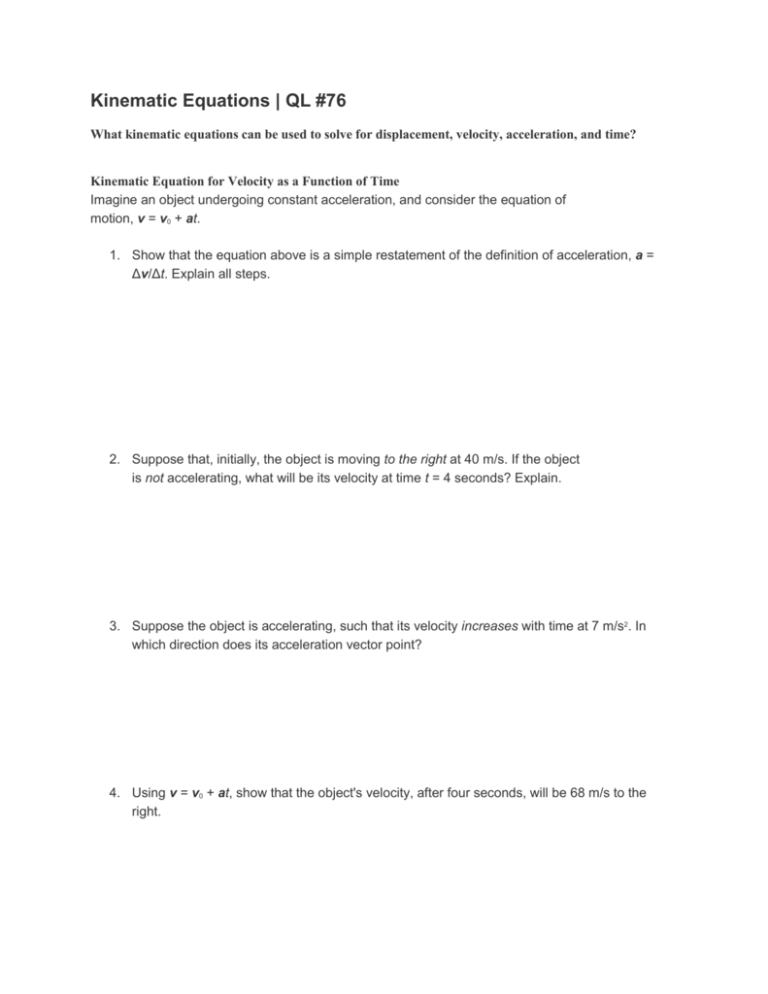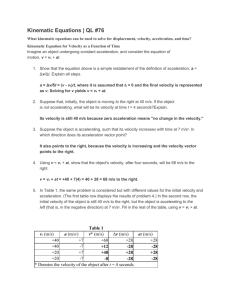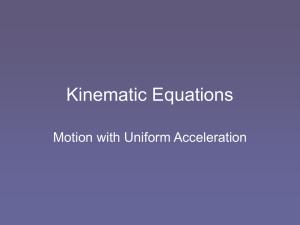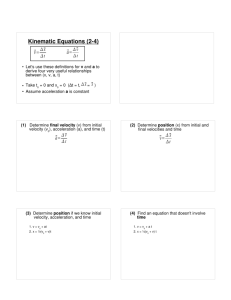Kinematic Equations | QL #76
advertisement

Kinematic Equations | QL #76 What kinematic equations can be used to solve for displacement, velocity, acceleration, and time? Kinematic Equation for Velocity as a Function of Time Imagine an object undergoing constant acceleration, and consider the equation of motion, v = v0 + at. 1. Show that the equation above is a simple restatement of the definition of acceleration, a = Δv/Δt. Explain all steps. 2. Suppose that, initially, the object is moving to the right at 40 m/s. If the object is not accelerating, what will be its velocity at time t = 4 seconds? Explain. 3. Suppose the object is accelerating, such that its velocity increases with time at 7 m/s2. In which direction does its acceleration vector point? 4. Using v = v0 + at, show that the object's velocity, after four seconds, will be 68 m/s to the right. 5. In Table 1, the same problem is considered but with different values for the initial velocity and acceleration. (The first table row displays the results of problem 4.) In the second row, the initial velocity of the object is still 40 m/s to the right, but the object is accelerating to the left (that is, in the negative direction) at 7 m/s2. Fill in the rest of the table, using v = v0 + at. Table 1 v* (m/s) +68 v0 (m/s) a (m/s ) Δv (m/s) at (m/s) +40 +7 +28 +28 +40 -7 +20 +7 +20 -7 * Denotes the velocity of the object after t = 4 seconds. 2 Kinematic Equation for Displacement as a Function of Time Now, consider the next kinematic equation for linear motion, d = v0t + (1/2)at2. 6. Why are the two terms, v0t and (1/2)at2, vectors? 7. Suppose an object starts out moving to the right at 4 m/s. If the object is not accelerating, explain why its displacement after t = 4 seconds will be 16 meters to the right. (This distance that is traveled with no acceleration will be called d.) 8. Suppose the object is accelerating such that its velocity increases with time at 1 m/s2. After four seconds, explain why its displacement, d, is 24 meters to the right. (Notice that this acceleration produces an increase in displacement, Δd, of 8 meters to the right.) 9. Fill in Table 2 for various initial velocities and accelerations. The first row has been completed for you. Table 2 d* v0t d** Δd (1/2)at2 v0 a +4 +16 +16 +1 +24 +8 +8 +4 -1 +2 +1 +2 -1 * Denotes the displacement that would occur if a = 0. ** Denotes the displacement of the accelerating object after t = 4 s. 12. For the first three columns in each row of Table 1, explain what is occurring physically. An example is provided below: In the first trial, the object is initially traveling to the right at 40 m/s, and is increasing in speed at a rate of 7 m/s2. This means its acceleration vector points to the right as well. After four seconds, the object is traveling at 68 m/s to the right. 13. By examining the last two columns in Table 1, summarize the physical significance of the at term in the equation v = v0 + at. How does the directionof the vector at affect your answer? 14. From Table 2, summarize the physical significance of the v0t and (1/2)at2 terms in the equation d = v0t + (1/2)at2. How does the direction of the acceleration vector, a, affect your answer?










